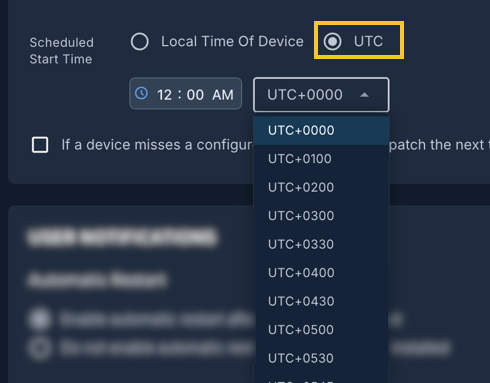Setting a Patching Schedule
Each policy or worklet must include a schedule. When creating or editing a policy, you can select from two schedule types:
- Custom: Select specific months, occurrences, and days.
- Patch Tuesday: Automatically schedule based on the second Tuesday of each month, with a configurable delay.
Setting a Custom Schedule
You can set a custom schedule from any policy or worklet page.
- From the Automate → Policies page, click Create Policy.
- Select the type of policy you want to create.
- In the Schedule section of the Create Policy or Create Worklet page, select Custom from the schedule options.
Use the following options to define the schedule:
- Months: Select one or more months such as JAN, FEB, or MAR.
- Occurrences: Select the occurrence of the day to run the policy: 1st, 2nd, 3rd, 4th, or 5th.
- Days: Select one or more days such as MON, TUE, or WED.
Example: To run a policy on the second Monday of June, select JUN, 2nd, and MON. This applies to the second occurrence of Monday in the month, regardless of the calendar week. For example, June 9, 2025, is the second Monday of the month but occurs in the third week.
-
Click Select All to preselect all months, occurrences, and days.
-
Deselect any options that do not apply. The calendar preview updates automatically.
Setting a Patch Tuesday Schedule
To set a Patch Tuesday schedule, select Patch Tuesday from the schedule type options.
You will see the following:
The number represents the number of days after Patch Tuesday when the policy runs. This number is selected from a drop-down list ranging from 0 to 14.
- Select 0 to run the policy on Patch Tuesday.
- The default value, 4, schedules the policy to run on the Saturday after Patch Tuesday.
- The policy always runs in relation to the second Tuesday of the month, based on the number of days you select.
Setting the Scheduled Start Time
You can specify whether the policy starts based on the device's local time or UTC.
Local Time of Device
- Select Local Time Of Device if you want the policy to start the update according to the time zone where the device is located.
- Use the drop-down list to set the start time.
- When multiple devices in different time zones are associated with the policy, the time of the update starts according to the time zone of each device.
UTC
- Select UTC to start the policy at the same universal time for all the devices
- Use the drop-down list to set the UTC start time. When multiple devices in different time zones are associated with the policy, the time of the update starts according to the UTC setting. All devices are updated at the same time, regardless of time zone.
Handling missed patches
You can decide how you want the device to patch if a configured patch time is missed. By selecting the checkbox after Scheduled Start Time, the device will patch the next time it checks in.

Complete any other options according to the policy or worklet you are creating or editing and select Create Policy or Save Policy.
Related Topics
- How to Use Global Scheduling in Automox Patch Management
- See our Community discussions around worklets




